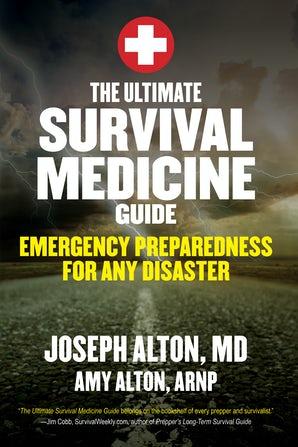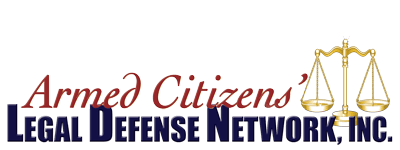The Ultimate Survival Medicine Guide:
Emergency Preparedness for ANY Disaster
By Joseph Alton M.D., and Amy Alton, ARNP
Publisher Skyhorse; 1st edition, August 4, 2015
Paperback 328 pages; eBook 312 pages
ISBN-13: 978-1629147703
$19.44 paperback at https://www.skyhorsepublishing.com/9781629147703/the-ultimate-survival-medicine-guide/ - eBook https://www.amazon.com/Ultimate-Survival-Medicine-Guide-Preparedness-ebook/dp/B00PSSELYK
Reviewed by Gila Hayes
Armed citizens put a high value on learning when and how to stop someone who intends to injure or kill them or their loved ones and rightly so. With so much focus on staying alive, it is ironic that we’re often less interested in learning how to avoid injury or disease. With self defense, we acknowledge that law enforcement may not be able to intervene in time to save our lives. Medical self-sufficiency suggests it is prudent to also understand how to maintain health and treat injury if access to medical care is interrupted by natural disaster or civil unrest.
This is the subject of The Ultimate Survival Medicine Guide by Joseph Alton M.D. and Amy Alton, ARNP. They introduce, “This book is meant to educate and prepare those who want to ensure the health of their loved ones. If you can absorb the information here, you will be better equipped to handle 90 percent of the emergencies that you would see in a power-down scenario, whether after a societal collapse or after a more typical disaster scenario. You will also have a realistic view of what medical issues are survivable without modern facilities.”
Similar books I’ve read mostly discussed first aid, so I was sobered when the authors commented that vigorous good health is hard to maintain under austere conditions. “Your immune system weakens when exposed to long-term stress, so you will be at risk for illnesses that a well-rested individual could easily weather,” they explain.
Without power or ways to assure clean water and food, the Altons predict that, “Infectious diseases would likely become rampant, and it will be a challenge to maintain sanitary conditions. Simple activities of daily survival, such as chopping wood, commonly lead to cuts that could get infected.” They comment later that an outbreak of diarrhea is more likely than a gun fight, illustrating, “In the Civil War, there were more deaths from dysentery than there were from bullet wounds.” I guess I need more bleach on my long-term supplies shelf, but I was also interested in their observation that a pressure cooker works as a makeshift autoclave if dressings or equipment need sterilization.
Contaminated water is the cause of a lot of disease, and the authors teach how to filter cloudy water, and then detail how to sterilize it. Options include boiling, or even better using a pressure cooker, chlorine, iodine or UV radiation – 6 to 8 hours under direct sunlight, they write.
Contaminated food is a bigger problem, they note, whether due to safe food storage problems, or food that is exposed to bacteria that is allowed to grow on prep surfaces, from the environment it was raised or ripened in, or by allowing raw meat juices to contact fruits or vegetables that are eaten raw.
Even with good hygiene and sanitation, infections sometimes have to be treated, they continue, so they dedicate an extensive section to infections. Cellulitis – soft tissue infections – can carry infection into the blood stream. “Cuts, bites, blisters, or cracks in the skin can all be entryways for bacteria to cause infections that could lead to sepsis if not treated,” they warn. Although no longer common in the US, tetanus infections are a risk, especially in deep, narrow wounds that aren’t open to oxygen. Abscesses and boils are a more common form of cellulitis and are harder to treat, they write, because the infection tends to be “walled off,” so opening a boil may be necessary. They outline incision and drainage, and options to antibiotic ointment, if it is not available.
Knife and gunshot wounds are covered, including importance of the first hour following the injury. This leads to a discussion of hemostatic agents like CeloxTM, but the authors note their use is not the first priority in treating a bleeding patient. “Pressure, elevation of a bleeding extremity above the heart, gauze packing, and tourniquets should be your strategy here. If these measures fail, however, you have an effective extra weapon to stop that hemorrhage,” they advise instead.
Sprains and joint injuries are covered, with a good, illustrated discussion of the physical structures involved and how to relieve pain, promote healing and sometimes prevent long-term disability. Fractures are a different matter, and the authors start with diagnostics, possible additional injuries like harm to nerves, then how to care for the injury under austere circumstances. Head injuries, open and closed, are also explained, with causes, symptoms, common results, and a discussion about when the greatest danger exists.
Realistic expectations about ones’ medical skills and resources are a nice aspect of The Ultimate Survival Medicine Guide. Discussing medical supplies that range from a personally carried first aid kit to a cache of supplies suitable for an improvised field hospital, the authors comment, “If you can put together a good family kit, you will have accomplished quite a bit. The list of items could go on and on, but the important thing is to accumulate supplies and equipment that you will feel competent using in the event of an illness or an injury.” They list about two dozen items for the family medical kit as a good start.
Quite a bit of discussion focuses on shouldering the medical needs of a smaller communal group, a lot of which strikes me as beyond the reach of most, so I was relieved to read, “Unfortunately, you probably will not have the resources needed to stockpile a massive medical arsenal. Even if you are able to do so, your supplies will last only a certain amount of time. Therefore, you will need a way to produce substances that will have a medical benefit. The plants in your own backyard or nearby woods would be the best place to start.” Throughout the chapters on various diseases and injuries, alternatives like veterinary antibiotics are identified, as are plants that help with common woes like pain, insect bites or stings, and even conditions commonly treated by prescription drugs that would eventually run out in a lengthy disruption of services.
Using natural remedies effectively requires recognizing common illnesses, and the authors discuss strep throat, respiratory infections, intestinal distress and a lot more. They also outline conventional treatments and improvised remedies for burns, animal and snake bites, insect and scorpion stings, spider bites and a lot more. All of that instruction is just as useful under normal conditions, as it would be under “austere” circumstances that are frequently referred to by the authors.
Since advancing into our senior years is often accompanied by chronic medical issues, I was interested to read the Altons’ ideas about medications that would become unavailable. The authors wrote, “Thyroid malfunction, diabetes, and heart disease are just some of these issues. They require medications that will not be manufactured in times of trouble. You must, therefore, think ‘outside the box’ to formulate a medical strategy for these patients that does not include modern technology.”
Under austere conditions treatment takes several directions, one being dietary restriction and supplementation. They list harmful and beneficial foods for people with thyroid disorders, diabetes, high blood pressure, heart disease, digestive system woes, seizures, kidney stones, and gall bladder stones. They identify pharmaceutical remedies that have good storage shelf life and others that deteriorate over time. Some common chronic disorders are relieved somewhat by herbs or natural supplements, they note, mentioning a variety of plants that could be useful, as well as pet and animal treatments that are available without prescription, but also discuss concerns that go along with drug allergies and related worries.
I learned a lot and have a renewed interest in herbal alternatives I’ll have to explore. I think the Altons’ message can be summed up in their advice to, “Be open to every strategy available to deal with a medical issue; there are a lot of tools in the medical woodshed, and you should take advantage of all methods that may keep your family and community healthy in uncertain times.” The Ultimate Survival Medicine Guide increased my awareness of various strategies, so I’m glad I ran across it.
To read more of this month's journal, please click here.
